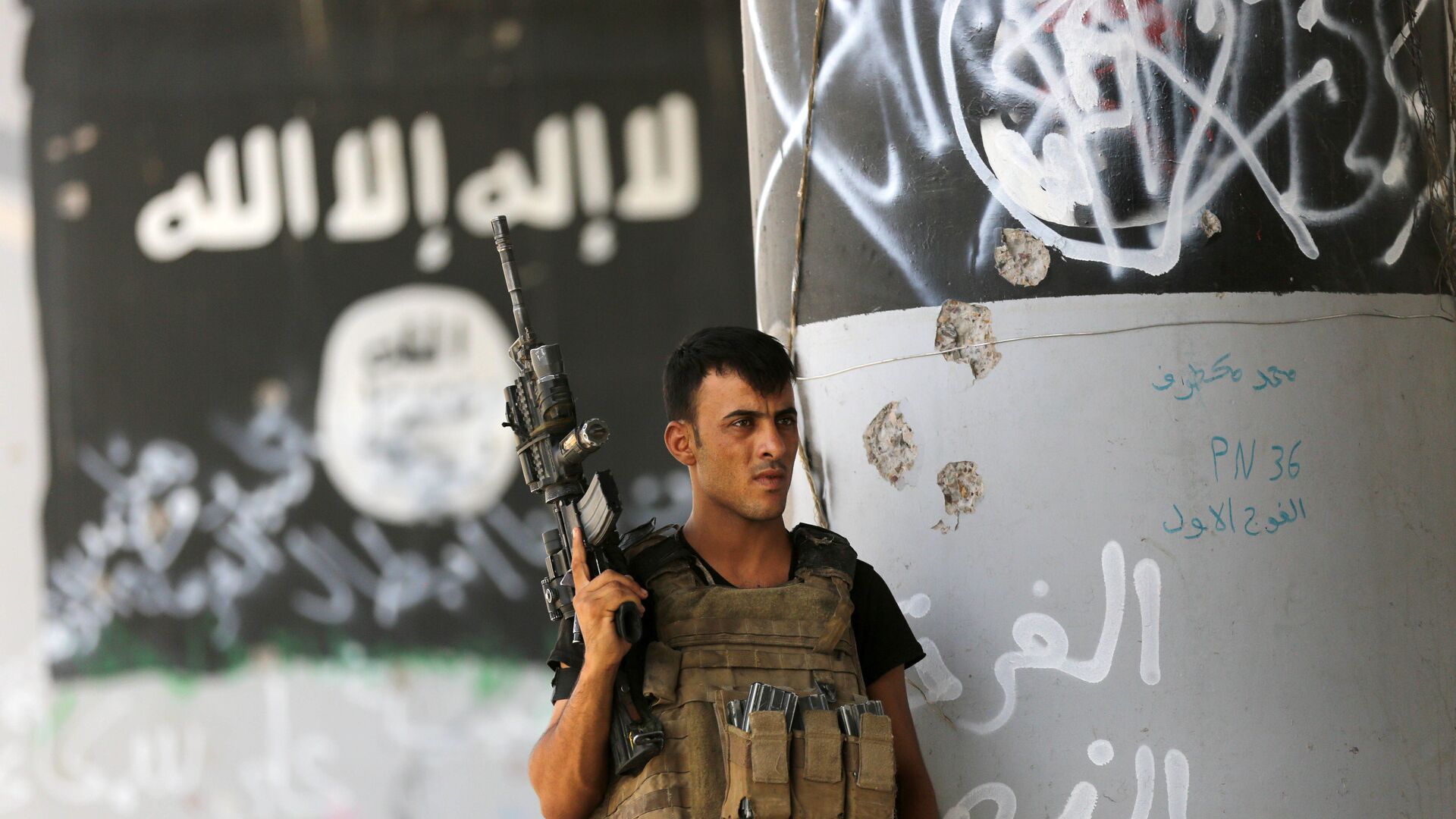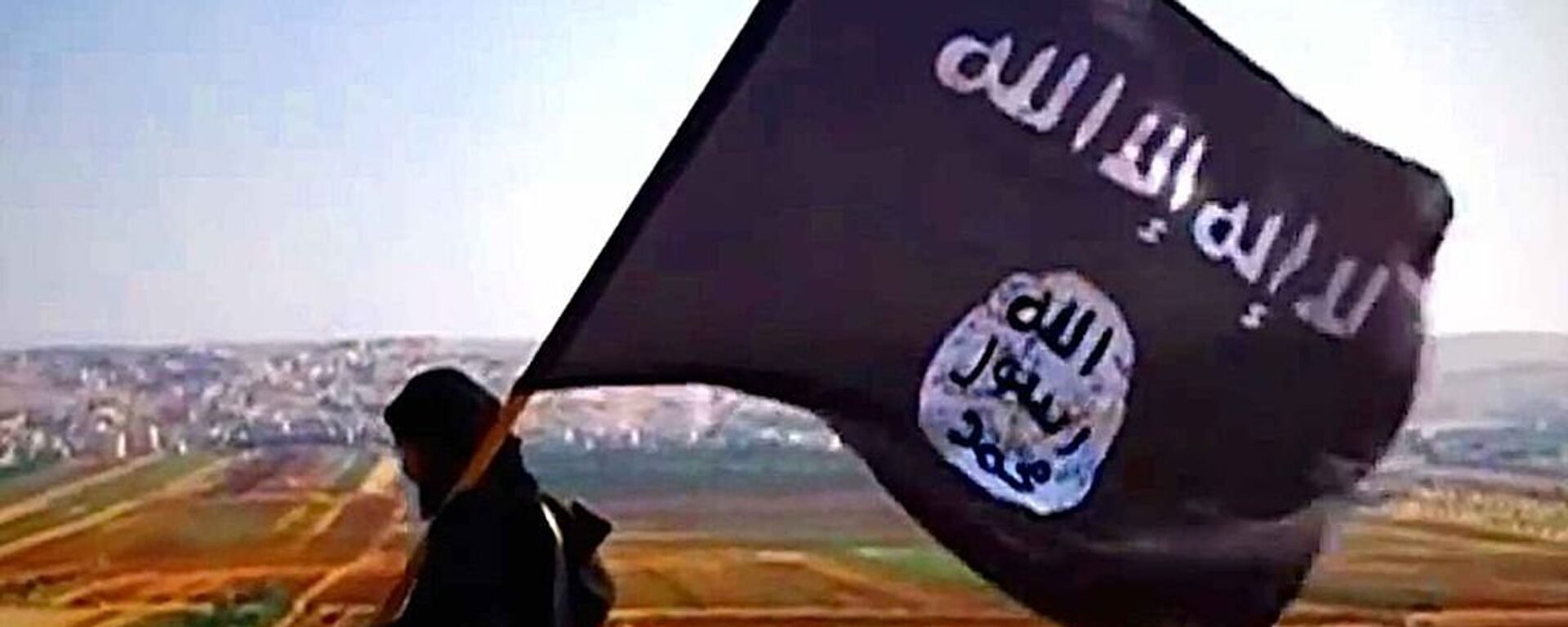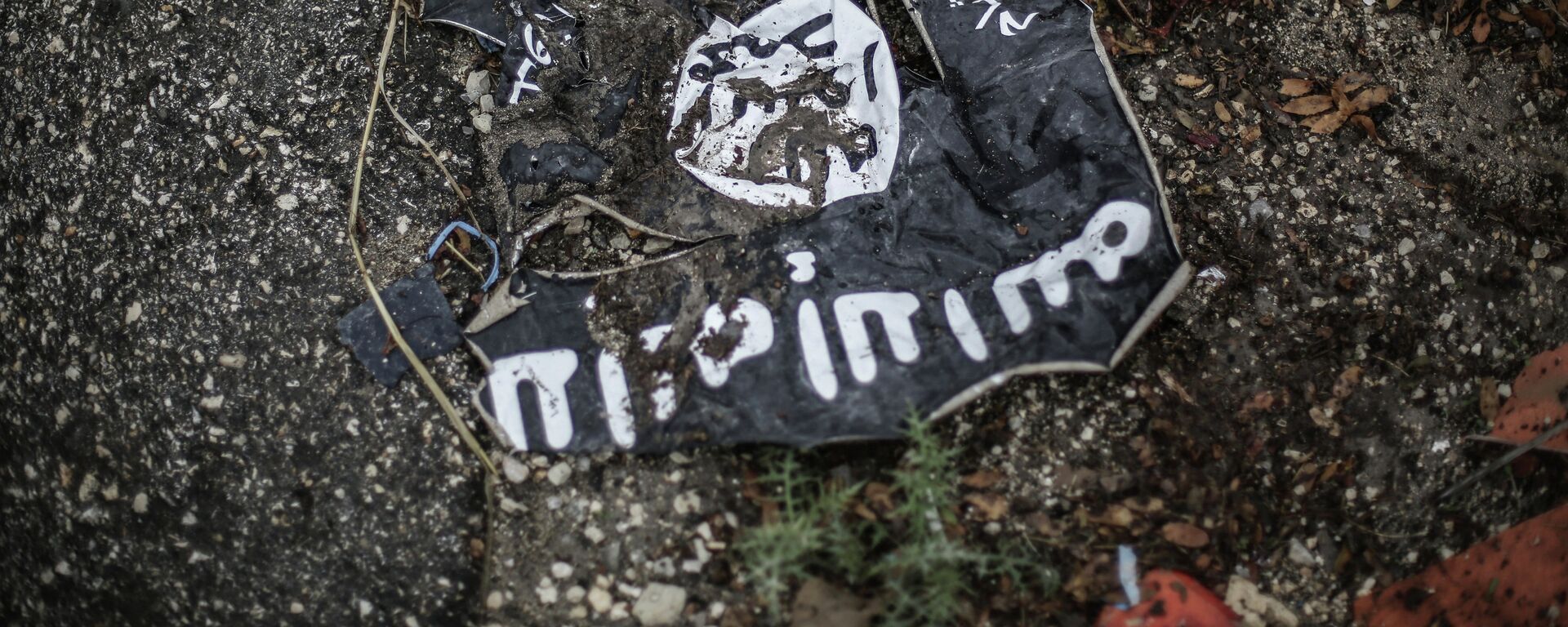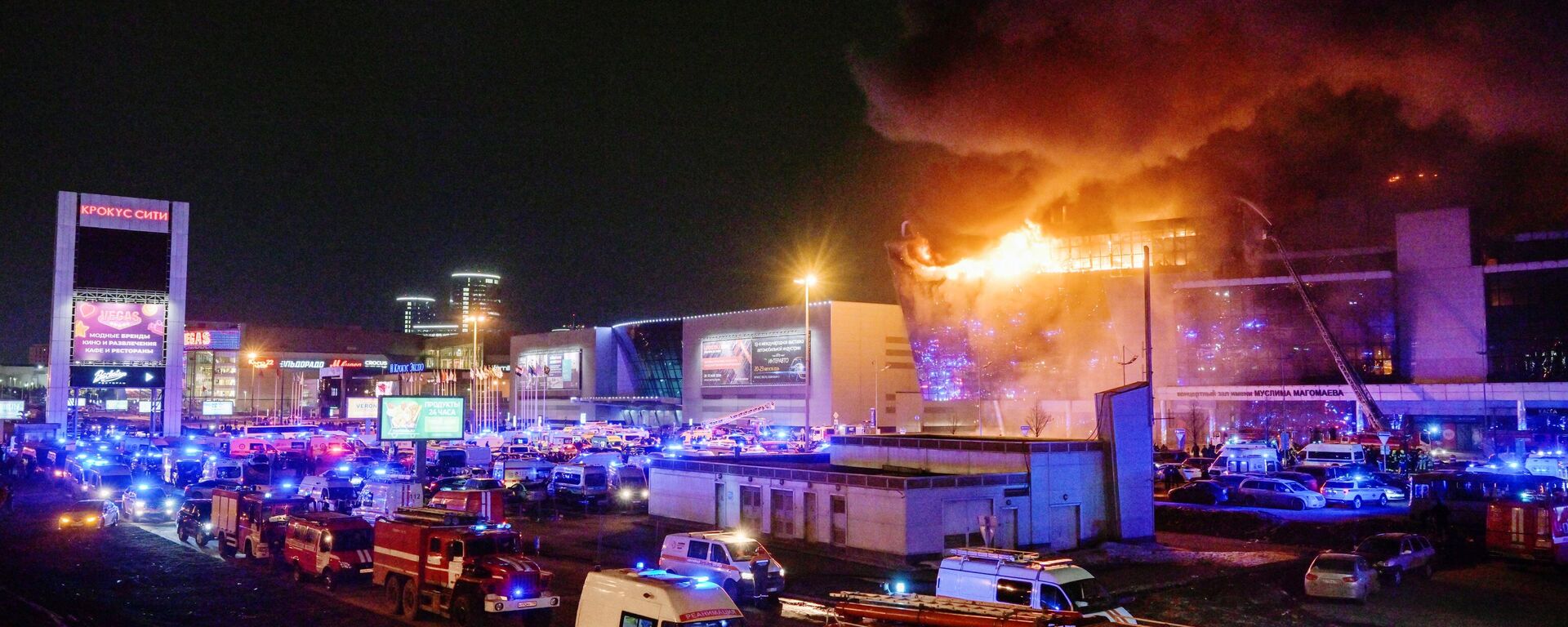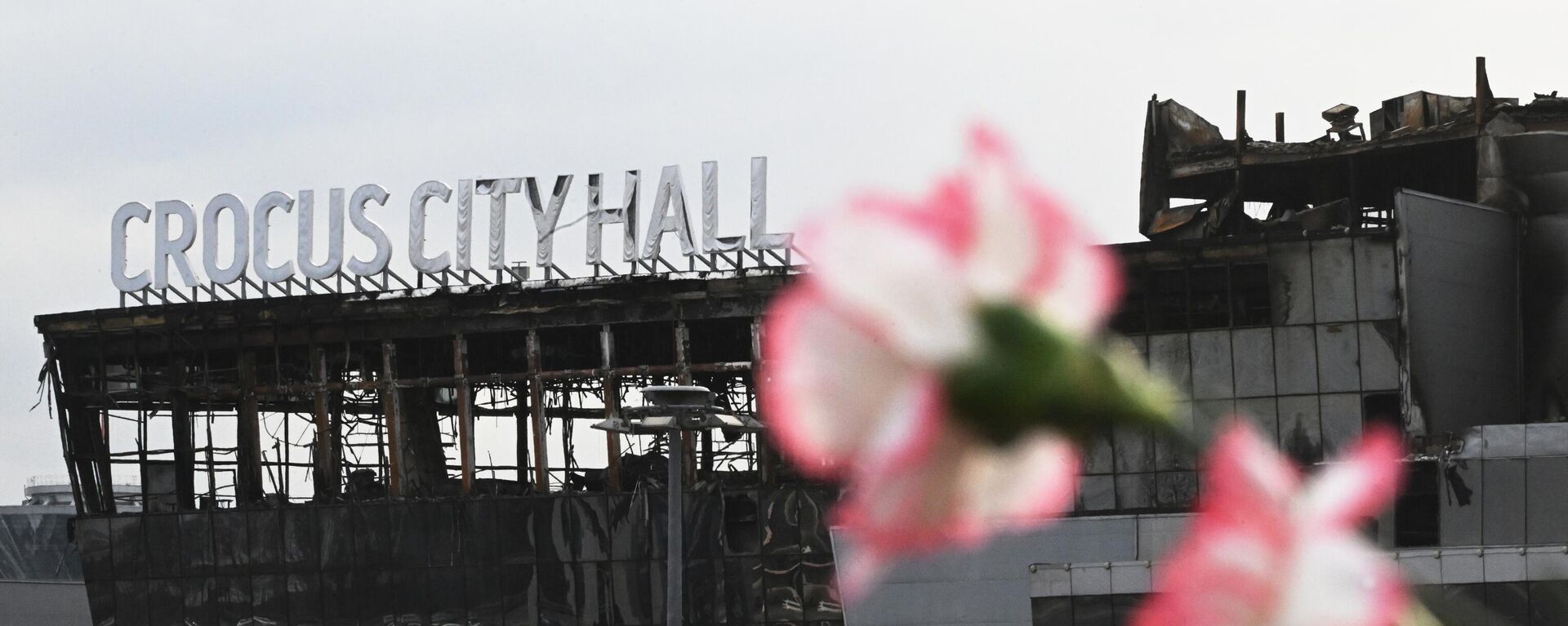https://sputnikglobe.com/20240329/how-ukraine-morphed-into-isis-terrorist-safe-haven-1117640571.html
How Ukraine Morphed Into ISIS Terrorist Safe Haven
How Ukraine Morphed Into ISIS Terrorist Safe Haven
Sputnik International
The West has long been aware of hundreds of ISIS* militants operating in Ukraine, which has transformed into nothing short of a safe haven for terrorists over the recent decades.
2024-03-29T17:32+0000
2024-03-29T17:32+0000
2024-03-29T17:32+0000
world
europe
matteo salvini
federica mogherini
ukraine
russia
donbass
ukrainian security service (sbu)
islamists
isis
https://cdn1.img.sputnikglobe.com/img/104727/82/1047278260_0:314:5353:3325_1920x0_80_0_0_d09f19ab5a3ade94e7fc1f6cc6106270.jpg
Back in July 2015, Italian MEP Matteo Salvini raised the issue of Islamists activities in Ukraine in an official request to Federica Mogherini, then the European Union's High Representative for Foreign Affairs and Security Policy.The request came on the heels of the New York Times' report about the presence of a Chechen volunteer force made up of ISIS* sympathizers in Donbass who fought against the Donetsk and Lugansk republics."It appears that they have openly sided with Ukraine in a bid to weaken Russia and compel it to concentrate its forces on that country, drawing resources away from other fronts on which it is pitted against various Islamic terrorist groups," Salvini wrote on July 27, 2015, adding that the Ukrainian authorities had neither denied the reports, nor expelled ISIS combatants from Ukraine."Given the serious danger posed by ISIS and Islamic terrorism in general, as confirmed recently by the tragic attacks in France and Tunisia, does the Vice-President/High Representative not consider it appropriate to rethink her stance regarding the conflict between Ukraine and Russia and engage in closer dialogue with Russia with a view to containing this fundamentalist threat?" the Italian MEP asked.ISIS Militants Living in Ukraine Untouched by SBUFour years later, The Independent reported about Georgian-born ISIS militant Cezar Tokhosashvili, also known as Al Bara Shishani, who managed to live quietly in the Ukrainian city of Belaya Tserkov for more than a year. He was eventually detained at the CIA's request.For some unknown reason, the Security Service of Ukraine (SBU), infamous for chasing after and cracking down on pro-Russian activists and political dissidents, had turned a blind eye to Tokhosashvili's presence in the country.In December 2020, Polish investigative journalist Pawel Pieniazek and his Ukrainian colleague Alyona Savchuk raised concerns that the Eastern European state was turning into nothing short of a safe haven for ISIS terrorists.It was revealed that Tokhosashvili had apparently worked as an unlicensed taxi driver or had a trading post at a market while living in Ukraine. According to journalists, the SBU claimed that he was an active member of ISIS during this time, recruiting new members, planning attacks, and coordinating the group's "security service." The reporters commented that if the CIA and the Georgian Interior Ministry had not sought his arrest, no one would have pursued the terrorist in Ukraine. Pieniazek and Savchuk also shared the story of "Musa," a Ukrainian man who had been radicalized, joined ISIS, fought in the Middle East, and then returned to Ukraine. They interviewed him in Kiev, which shows that the SBU had not taken any action to apprehend him as well.Ukraine: a Transit Point for ISIS TerroristsThe journalists noted that Ukraine, for years, has served as a key transit hub for terrorists travelling to and from Syria. ISIS militants were transported from the North and South Caucasus and Central Asian countries through Ukraine to Turkiye and then on to Syria and Iraq. The intensification of the flow of terrorists coincided with the Maidan coup d'etat of February 2014 and the new Kiev regime's war on Donbass. As a result, the Ukrainian security services paid little or no attention to the movement of ISIS fighters.Facing obstacles upon returning to their countries of origin, these jihadists opted to settle in Ukraine. The Independent pointed out that Ukraine has long had gaps in its legal and law enforcement systems, much to the benefit of terrorists and organized crime. Obtaining fake passports, including biometric ones, doesn't seem to be a big problem in Ukraine if one could pay for it in cold hard cash. A former British intelligence agent cited by the newspaper said at the time, that "it is a vulnerability that Kiev does not seem entirely interested in addressing."According to Pieniazek and Savchuk, ISIS fighters either flew by plane and went through passport control with real or forged documents or crossed the Black Sea illegally by ferry. "If a militant is not included in the Interpol database, he can easily enter Ukraine," the journalists wrote.As of 2020, the SBU claimed it had blocked 443 people linked to ISIS from entering Ukraine. However, the number of those who snuck into the Eastern European state could amount to several hundreds, the journalists said, echoing Mironova's figures.Unholy Alliance of Neo-Nazis and JihadistsThere is more to the story than meets the eye. An unholy alliance of Islamists and Ukrainian nationalists existed long before the Syrian Civil War or Ukraine's war against Donbass broke out.Ukrainian mercenaries were spotted fighting in the First (1994-1996) and Second Chechen (1999-2009) wars on the side of the Chechen jihadi insurgents. According to the memoirs of Colonel General Gennady Troshev, who commanded a group of Russian federal forces in the North Caucasus, in December 1999, there were roughly 300 Ukrainian mercenaries in the Chechen city of Grozny.The Ukrainian National Assembly - Ukrainian People's Self-Defense** (UNA-UNSO) is believed to be the first organization of Ukrainian nationalists which prepare hirelings for "export". Since the 1990s, they took part in hostilities against Russian forces in Transnistria, South Ossetia, and Chechnya, and during the 2008 operation to force Georgia to peace.After completing their involvement in combat in the Caucasus, numerous Ukrainian mercs returned to their native country without facing any legal consequences. However, some of them eventually ended up arrested while in the Chechen Republic. In 2016, the Supreme Court of Chechnya sentenced two Ukrainian citizens, Nikolai Karpyuk and Stanislav Klykh, to lengthy prison terms of 22.5 and 20 years, respectively. These mercenaries had fought alongside insurgent groups led by Aslan Maskhadov and Shamil Basayev during the first Chechen war. Their actions resulted in the deaths of both civilians and members of the military and security forces.Since the collapse of the USSR, Ukraine has gradually transformed into a sanctuary state for various gangs and mercenaries. Therefore, it is not shocking that the jihadists apprehended in the Crocus City Hall terror massacre were on their way to Ukraine, with ties to individuals on the Ukrainian side, according to the Russian Federal Security Service (FSB). The Russian Investigative Committee declared on Thursday that they have acquired proof linking the terrorists involved in the carnage with Ukrainian nationalists. Additionally, it was revealed that the terrorists received substantial sums of money and cryptocurrency from Ukraine."The investigation has confirmed that significant amounts of money and cryptocurrencies were received from Ukraine by the perpetrators of the terrorist attack, which were then used in plotting the crime," the Russian detectives emphasized.*terrorist group banned in Russia and many other countries. **extremist group banned in Russia.
https://sputnikglobe.com/20240326/russian-intelligence-services-kept-eye-on-wests-effort-to-weaponize-isis--1117565239.html
https://sputnikglobe.com/20240325/how-did-notorious-isis-terrorist-manage-to-live-quietly-in-ukraine-for-months-1117540485.html
https://sputnikglobe.com/20240325/in-bed-with-jihadists-and-neo-nazis-why-crocus-city-hall-terror-attack-cast-slur-upon-west-1117544799.html
https://sputnikglobe.com/20220304/why-is-the-west-silent-about-ukrainian-neo-nazi-movements-azov-battalion--bandera-legacy-1093561142.html
https://sputnikglobe.com/20240329/russian-investigators-say-crocus-city-hall-terrorists-planned-to-travel-to-kiev-to-claim-reward-1117641608.html
ukraine
russia
donbass
Sputnik International
feedback@sputniknews.com
+74956456601
MIA „Rossiya Segodnya“
2024
News
en_EN
Sputnik International
feedback@sputniknews.com
+74956456601
MIA „Rossiya Segodnya“
Sputnik International
feedback@sputniknews.com
+74956456601
MIA „Rossiya Segodnya“
isis, ukraine, ukraine is a transit point to isis, ukraine is a safe haven for isis, crocus city hall terror attack, ukrainian neo-nazis, chechen wars, italian mep salvini, chechen battalions fought in donbass, chechen isis sympathizers fought on ukraine side, international terrorism
isis, ukraine, ukraine is a transit point to isis, ukraine is a safe haven for isis, crocus city hall terror attack, ukrainian neo-nazis, chechen wars, italian mep salvini, chechen battalions fought in donbass, chechen isis sympathizers fought on ukraine side, international terrorism
How Ukraine Morphed Into ISIS Terrorist Safe Haven
The West has long been aware of hundreds of ISIS* militants operating in Ukraine, which has transformed into nothing short of a safe haven for terrorists over the recent decades.
Back in July 2015, Italian MEP Matteo Salvini raised the issue of Islamists activities in Ukraine in an official request to Federica Mogherini, then the European Union's High Representative for Foreign Affairs and Security Policy.
The request came on the heels of the New York Times' report about the presence of a Chechen volunteer force made up of ISIS* sympathizers in Donbass who fought against the Donetsk and Lugansk republics.
There were at least three "volunteer Islamic battalions" operating in the most volatile regions of the area alongside Ukrainian nationalists, according to the paper. One of these groups, called the Sheikh Mansur group, was affiliated with Ukraine's extremist Right Sector**, who played a significant role in the ousting of Ukrainian President Viktor Yanukovich in February 2014. In a separate incident linked to the issue at hand, French authorities apprehended two members of the Sheikh Mansur group on suspicion of having ties to ISIS.
"It appears that they have openly sided with Ukraine in a bid to weaken Russia and compel it to concentrate its forces on that country, drawing resources away from other fronts on which it is pitted against various Islamic terrorist groups," Salvini wrote on July 27, 2015, adding that the Ukrainian authorities had neither denied the reports, nor expelled ISIS combatants from Ukraine.
"Given the serious danger posed by ISIS and Islamic terrorism in general, as confirmed recently by the tragic attacks in France and Tunisia, does the Vice-President/High Representative not consider it appropriate to rethink her stance regarding the conflict between Ukraine and Russia and engage in closer dialogue with Russia with a view to containing this fundamentalist threat?" the Italian MEP asked.
ISIS Militants Living in Ukraine Untouched by SBU
Four years later, The Independent reported about Georgian-born
ISIS militant Cezar Tokhosashvili, also known as Al Bara Shishani, who managed to live quietly in the Ukrainian city of Belaya Tserkov for more than a year. He was eventually detained at the CIA's request.
For some unknown reason, the Security Service of Ukraine (SBU), infamous for chasing after and
cracking down on pro-Russian activists and political dissidents, had turned a blind eye to Tokhosashvili's presence in the country.
Vera Mironova, a scholar specializing on the topic of jihad and visiting fellow at Harvard University, told the newspaper that "hundreds" of ISIS fighters had hightailed it to Ukraine in the aftermath of the group's defeat in Syria and Iraq.
In December 2020, Polish investigative journalist Pawel Pieniazek and his Ukrainian colleague Alyona Savchuk raised concerns that the Eastern European state was turning into nothing short of a safe haven for ISIS terrorists.
It was revealed that Tokhosashvili had apparently worked as an unlicensed taxi driver or had a trading post at a market while living in Ukraine. According to journalists, the SBU claimed that he was an active member of ISIS during this time, recruiting new members, planning attacks, and coordinating the group's "security service." The reporters commented that if the CIA and the Georgian Interior Ministry had not sought his arrest, no one would have pursued the terrorist in Ukraine.
Pieniazek and Savchuk also shared the story of "Musa," a Ukrainian man who had been radicalized, joined ISIS, fought in the Middle East, and then returned to Ukraine. They interviewed him in Kiev, which shows that the SBU had not taken any action to apprehend him as well.
Ukraine: a Transit Point for ISIS Terrorists
The journalists noted that Ukraine, for years, has served as a key transit hub for terrorists travelling to and from Syria. ISIS militants were transported from the North and South Caucasus and Central Asian countries through Ukraine to Turkiye and then on to Syria and Iraq.
The intensification of the flow of terrorists coincided with the Maidan coup d'etat of February 2014 and the new Kiev regime's war on Donbass. As a result, the Ukrainian security services paid little or no attention to the movement of ISIS fighters. Facing obstacles upon returning to their countries of origin, these jihadists opted to settle in Ukraine. The Independent pointed out that Ukraine has long had gaps in its legal and law enforcement systems, much to the benefit of terrorists and organized crime. Obtaining fake passports, including biometric ones, doesn't seem to be a big problem in Ukraine if one could pay for it in cold hard cash. A former British intelligence agent cited by the newspaper said at the time, that "it is a vulnerability that Kiev does not seem entirely interested in addressing."
According to Pieniazek and Savchuk, ISIS fighters either flew by plane and went through passport control with real or forged documents or crossed the Black Sea illegally by ferry. "If a militant is not included in the Interpol database, he can easily enter Ukraine," the journalists wrote.
As of 2020, the SBU claimed it had blocked 443 people linked to ISIS from entering Ukraine. However, the number of those who snuck into the Eastern European state could amount to several hundreds, the journalists said, echoing Mironova's figures.
Unholy Alliance of Neo-Nazis and Jihadists
There is more to the story than meets the eye. An unholy alliance of Islamists and Ukrainian nationalists existed long before the Syrian Civil War or Ukraine's war against Donbass broke out.
Ukrainian mercenaries were spotted fighting in the First (1994-1996) and Second Chechen (1999-2009) wars on the side of the Chechen jihadi insurgents. According to the memoirs of Colonel General Gennady Troshev, who commanded a group of Russian federal forces in the North Caucasus, in December 1999, there were roughly 300 Ukrainian mercenaries in the Chechen city of Grozny.
The Ukrainian National Assembly - Ukrainian People's Self-Defense** (UNA-UNSO) is believed to be the first organization of Ukrainian nationalists which prepare hirelings for "export". Since the 1990s, they took part in hostilities against Russian forces in Transnistria, South Ossetia, and Chechnya, and during the 2008 operation to force Georgia to peace.
After completing their involvement in combat in the Caucasus, numerous Ukrainian mercs returned to their native country without facing any legal consequences. However, some of them eventually ended up arrested while in the Chechen Republic. In 2016, the Supreme Court of Chechnya sentenced two Ukrainian citizens, Nikolai Karpyuk and Stanislav Klykh, to lengthy prison terms of 22.5 and 20 years, respectively. These mercenaries had fought alongside insurgent groups led by Aslan Maskhadov and Shamil Basayev during the first Chechen war. Their actions resulted in the deaths of both civilians and members of the military and security forces.
Since the collapse of the USSR, Ukraine has gradually transformed into a sanctuary state for various gangs and mercenaries. Therefore, it is not shocking that the jihadists apprehended in the Crocus City Hall terror massacre were on their way to Ukraine, with ties to individuals on the Ukrainian side, according to the Russian Federal Security Service (FSB). The Russian Investigative Committee declared on Thursday that they have acquired proof linking the terrorists involved in the carnage
with Ukrainian nationalists. Additionally, it was revealed that the terrorists received substantial sums of money and cryptocurrency from Ukraine.
"The investigation has confirmed that significant amounts of money and cryptocurrencies were received from Ukraine by the perpetrators of the terrorist attack, which were then used in plotting the crime," the Russian detectives emphasized.
*terrorist group banned in Russia and many other countries.
**extremist group banned in Russia.
